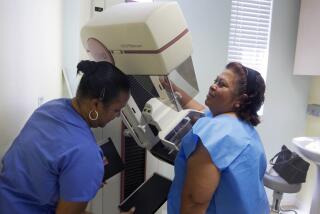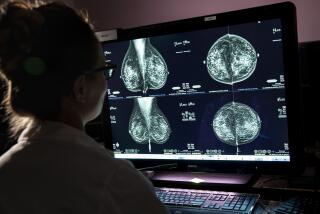More Women Are Having Mammograms, Study Shows : Health: 64% of those over age 40 have had at least one test. But less than a third follow guidelines for periodic exams.
- Share via
WASHINGTON — The number of American women age 40 and older who have had at least one mammogram has jumped dramatically during the last three years, but fewer than one in three are having them on a regular basis, according to a study released Thursday.
“I think it’s encouraging, but it also means we still have to do more,” said Dr. Sam Broder, director of the National Cancer Institute, a sponsor of the study.
The study examined women’s attitudes toward mammography, a low-dose X-ray procedure used to detect breast cancer, which has become the second leading cause of cancer death in American women after lung cancer.
Conducted last February, the survey of 980 women age 40 and older showed that 64% have had at least one mammogram, up from 37% in 1987. Nevertheless, the study also indicated that only 31% are following recommended guidelines that call for regular mammograms after the age of 40.
“I think it involves the same psychology that human beings use when they go to the dentist: If they get a good report, they don’t go back until they have a toothache,” said Dr. Daniel Nixon, vice president for professional education for the American Cancer Society.
Marion Nadel, an epidemiologist with the cancer prevention and control branch of the Centers for Disease Control, agreed. “Women think they don’t need to have another one if the first one shows they’re OK,” she said. “But having one is not enough.”
The study was sponsored by the cancer institute and the Jacobs Institute of Women’s Health, a nonprofit organization founded by the American College of Obstetricians and Gynecologists. The CDC published the results in today’s issue of its Morbidity and Mortality Weekly Report.
An estimated 150,900 new cases of breast cancer will be diagnosed in the United States this year, and the disease will cause about 44,300 deaths, according to the American Cancer Society. The Centers for Disease Control said nearly one-third of those deaths could be prevented by regular mammograms.
An estimated one in 10 women in this country is expected to develop breast cancer. While the incidence rates are increasing, early detection and improved treatment have kept mortality rates fairly stable during the past 50 years, according to the American Cancer Society.
More than a dozen major medical organizations, including the cancer institute and the American Cancer Society, have recommended that all women 40 and older have regular mammograms--every one to two years for women 40 to 49 and annually for women 50 and older. Mammograms can reveal cancers as much as two years before they are large enough to be felt, even by the most experienced clinicians.
Experts attributed the sharp rise in one-time mammograms to an increase in programs that promote the benefits of early breast cancer detection, in addition to the growing number of doctors who are recommending the procedure.
Nearly three-quarters of all women who had mammograms did so because their doctors suggested it, but 45% of those who had never had a mammogram said their doctors had not recommended one, the study said.
A survey conducted in 1989 by the cancer society showed that 37% of physicians said they followed the recommended guidelines for their patients, up from 11% in 1984.
“Physicians are doing a better job now than they did a few years ago, but it’s not good enough,” said Nadel.
Women with higher income levels were more likely to have had mammograms: 77% of those with household incomes greater than $50,000 had undergone the procedure, compared with 60% of those with household incomes below $25,000.
Women 65 and older are less likely to get regular mammograms, even though they are more likely to develop breast cancer, according to the study. Only 24% of women in this age group said they followed the recommended guidelines.
The study showed that 40% of women who had not undergone a mammogram said one reason was because no one in their family had ever had breast cancer. While a family history of breast cancer increases the risk of developing the disease, 80% of women who get breast cancer have no such family history, the study said.
Of those women who have had only one mammogram and are not following the guidelines, 35% said they felt no need to undergo the procedure again because their first mammogram showed no problems, while 29% said that mammograms cost too much.
The fear of the radiation associated with the procedure was cited as a disincentive. But Nadel said the amount of radiation involved “is negligible today and should not deter women from receiving regular mammograms.”
GAINS IN MAMMOGRAPHY
The percentage of women age 40 and older who reported having had at least one mammogram.
Surveys In percent 1990 1987 RACE White 65 39 Black 58 30 AGE 40-49 64 41 50-59 71 44 60-69 65 38 70 and over 56 28 ANNUAL INCOME Less than $25,000 60 32 More than $25,000 77 47 EDUCATION Less than high school 58 25 High school 65 41 Some college 72 49 College 74 49 Total 64 37






